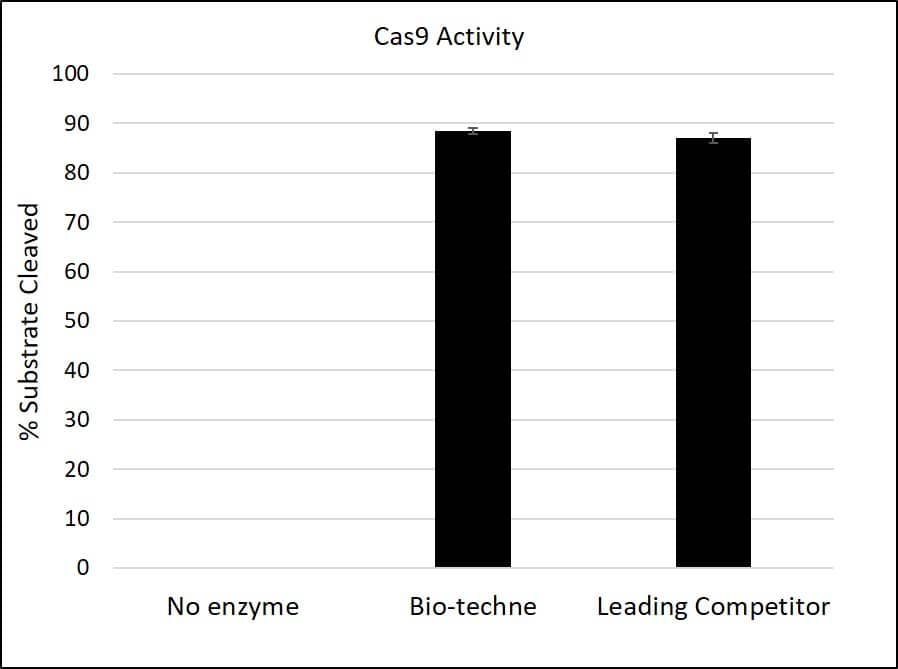Recombinant S. pyogenes CRISPR-associated Protein 9, CF
R&D Systems, part of Bio-Techne | Catalog # 9957-C9
Purified CAS9 with Nuclear Localization Sequence

Key Product Details
- R&D Systems E. coli-derived Recombinant S. pyogenes CRISPR-associated Protein 9 (9957-C9)
- Quality control testing to verify active proteins with lot specific assays by in-house scientists
- All R&D Systems proteins are covered with a 100% guarantee
Source
E. coli
Conjugate
Unconjugated
Applications
Enzyme Activity
Product Specifications
Source
E. coli-derived s. pyogenes CRISPR-Cas9 protein
| APKKKRKVGIHGVPAA | S. pyogenes CRISPR-Cas9 (Asp2-Asp1368) Accession # Q99ZW2 |
KRPAATKKAGQAKK-KKGYGRKKRRQRRRG | HHHHHH |
| N-terminus | C-terminus | ||
Purity
>95%, by SDS-PAGE visualized with Silver Staining and quantitative densitometry by Coomassie® Blue Staining.
Endotoxin Level
<0.10 EU per 1 μg of the protein by the LAL method.
N-terminal Sequence Analysis
Ala
Predicted Molecular Mass
164 kDa
SDS-PAGE
133 kDa, reducing conditions
Activity
Measured by its ability to cleave a targeted DNA substrate.
S. pyogenes CRISPR-Cas9 achieves >80% substrate cleavage, as measured under the described conditions.
S. pyogenes CRISPR-Cas9 achieves >80% substrate cleavage, as measured under the described conditions.
Scientific Data Images for Recombinant S. pyogenes CRISPR-associated Protein 9, CF
Recombinant S. pyogenes CRISPR-associated Protein 9 Bioactivity
Quantitative analysis of the substrate cleavage by densitometry of the agarose gel. Error bars display standard error of 3 replicates. 9957-C9 has equivalent activity to a Leading Competitor's Cas9 using the insert assay protocol.Recombinant S. pyogenes CRISPR-associated Protein 9 Bioactivity
Agarose gel image of in vitro cleavage of DNA substrate into two DNA products by 9957-C9 and a Leading Competitor's Cas9.Recombinant S. pyogenes CRISPR-associated Protein 9 SDS-PAGE
2 μg/lane of Recombinant S. pyogenes CRISPR-Cas9 was resolved with SDS-PAGE under reducing (R) and non-reducing (NR) conditions and visualized by Coomassie® Blue staining, showing a band at ~130 kDa.Formulation, Preparation and Storage
9957-C9
| Formulation | Supplied as a 0.2 μm filtered solution in Tris, NaCl, EDTA, Glycerol and TCEP. |
| Shipping | The product is shipped with polar packs. Upon receipt, store it immediately at the temperature recommended below. |
| Stability & Storage | Use a manual defrost freezer and avoid repeated freeze-thaw cycles.
|
Background: CRISPR-Cas9
References
- Feng, Z. et al. (2013) Cell 154:1380.
- Moineau. et al. (2010) Nature 468:67.
- Barrangou, R. et al. (2014) Molecular Cell 54:234.
- Charpentier, E. et al. (2011) Nature 471:602.
- Heler, R. et al. (2015) Nature 519:199.
- Thomson, J.A. et al. (2013) PNAS,110:15644.
- Cong, L. et al. (2013) Science 339:819.
Long Name
CRISPR-associated Protein 9
Alternate Names
Cas9, CRISPR-associated endonuclease Cas9/Csn1, CRISPR-Cas9/Csn1, CRISPR/Cas9, csn1, SPy_1046, SPy1046, SpyCas9
Entrez Gene IDs
901176 (S. pyogenes)
Gene Symbol
CAS9
Additional CRISPR-Cas9 Products
Product Documents for Recombinant S. pyogenes CRISPR-associated Protein 9, CF
Product Specific Notices for Recombinant S. pyogenes CRISPR-associated Protein 9, CF
For research use only
